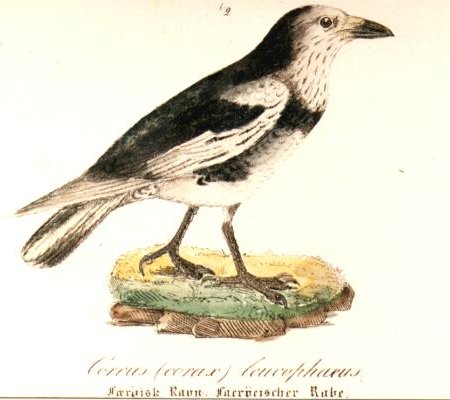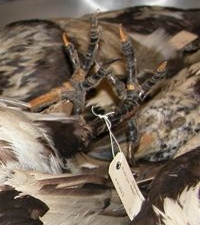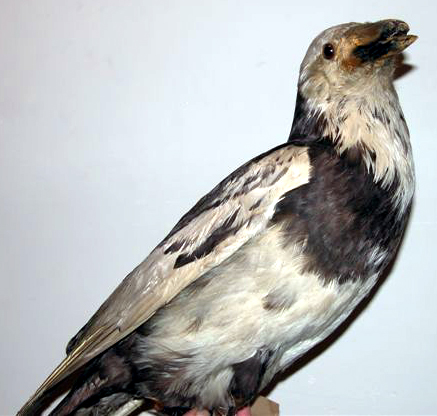Hvítravnur
The Pied Raven (Corvus corax varius morpha leucophæus) was endemic to Faroe Islands (Hvítravnur is Færoese for “White Raven”) and is now believed to be extinct.
As recounted by Robert Gray in his The Birds of the West of Scotland, including the Outer Hebrides, William MacGillivray, 19th century Scottish ornithologist, encountered a Pied Raven on the island of Harris of Outer Hebrides and described it as a distinct species, Corvus leucophæus.* As quoted in Charles Darwin’s Natural Selection, MacGillivray observed that the bill of the Pied Raven compared to other Ravens “is much larger being not only higher at the base, but more elongated,& in form more attenuated at the end.” It is not specified in the text whether or not MacGillivray was comparing the Pied Raven to the nominate subspecies or to other specimens of C. c. varius found on Iceland and Faroe Islands. The individual encountered by MacGillvray on the Outer Hebrides was an estranged wanderer, who being not well-received as far from Faroese territory, was a “neglected & persecuted stranger.”
According to Carl Julian von Graba, regarded as one of the first researchers of Faroe Islands, even on their own homeland, the Pied Ravens were mobbed by the common Ravens. Nevertheless, they managed to procreate. As published in 1830, Graba noted that when a Black Raven mated with a Pied Raven, the offspring would be either all black or else only one of the offspring would be Pied. This was corroborated later at a meeting in Edinburgh in 1850, as Robert Gray describes in his text. So while this observation is damning evidence against the claim that Pied Ravens were a distinct species, it is suggestive of recessive mutation or mutations possibly.
Robert Gray included in his text quite an unforgiving censure of MacGillivray’s description as a species:
“. . . the entire aspect of the bird is opposed to the idea of specific differences, the appearance of the feathers and the light coloured claws and want of symmetry in the wing markings proving it to be only a spotted bird which might ultimately have become an albino. It is rather singular that this painstaking naturalist should have allowed himself in this instance to be decieved.”
Interestingly, it is not clear how the affecting mutation(s) differ(s) from albinism. Graba reported (according to Charles Darwin’s Natural Selection) that the Pied Ravens were at first mostly white and that black feathers appeared with age. C. c. varius, of Iceland and Faroe Islands, normally exhibit tendency for whiteness at the bases of feather barbs, but the extensively Pied morph population was found only on the Faroe Islands.wiki
Even the harder integumentary keratin in the claw and podotheca is amelanic in selected areas. Rhinotheca (exterior covering of maxillary beak) is also fawnish in color. © Erik Christensen
No Pied Ravens have been spotted after 1948, the year in which Faroe Islands became an autonomous province of the Kingdom of Denmark (as opposed to a county under Danish rule). Failure of the population is linked to lack of assortative mating among Pied individuals as well as preferential hunting of them.wiki While Ravens in general were exterminated as pests, Victorians appreciated the oddity, and collectors were willing to pay for bespeckled specimens.
© Erik Christensen
*Actually, Louis Jean Pierre Vieillot (who was both ornithogist and aviculturist in one, as he also raised finches), was the first to apply the binomial, Corvus leucophæus, but there is at present no species recognized by that name.











[…] In ornithology, it’s just as important to raise good questions as it is to find answers–and what birder doesn’t love a mystery? Check out finchwench’s exploration of the puzzling Pied Raven, or Hvítravnur. […]
Jeffrey A. Gordon » I and the Bird #90: Christmas Count Tally Rally said this on Thursday, 11 December 2008 at 2:07 |